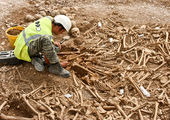
© Melillo/Maxson/ESA/University of Wisconsin-Madison/ALPOA new, bright spot in the clouds of Venus was found by amateur astronomer Frank Melillo on 19 July
A strange spot emerged on Venus last week, and astronomers are not sure what caused it. They hope future observations will reveal whether volcanic activity, turbulence in the planet's atmosphere, or charged particles from the sun are to blame.
Amateur astronomer Frank Melillo of Holtsville, New York, first spotted the new feature, which is brighter than its surroundings at ultraviolet wavelengths, on the planet's southern hemisphere on 19 July. That same day, an amateur observer in Australia found a dark spot on Jupiter that had been caused by a meteoroid impact.
The Venus spot was confirmed by other observers, and images from Europe's Venus Express, the only spacecraft in orbit around the planet, later revealed that the spot had appeared at least four days before Melillo saw it.
Observations show that the spot had already spread out somewhat by the end of last week, and astronomers are awaiting more recent observations from Venus Express.
The spot is bright at ultraviolet wavelengths, which may argue against a meteoroid impact as a cause. That's because rocky bodies, with the exception of objects very rich in water ice, should cause an impact site to darken at ultraviolet wavelengths as it fills with debris that absorbs such light, says Sanjay Limaye of the University of Wisconsin-Madison and a member of the Venus Express team.



Comment: These are possibilities, of course. One may want to consider this as well: Military Hush-Up: Incoming Space Rocks Now Classified